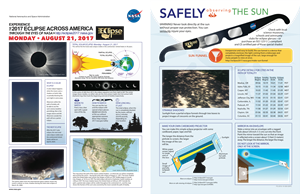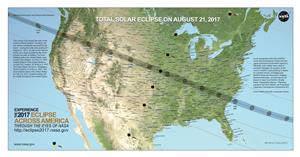- West Contra Costa Unified School District
- Solar Eclipse: August 21, 2017
-
The "Great American Solar Eclipse" will be viewable (weather permitting) from sites in WCCUSD on Monday August 21, 2017 from 9:01am to 11:37am. From our vantage point in California, the moon will cover about 80% of the sun at its maximum at 10:15am.
August 21 Total Solar Eclipse Fact Sheet (downloadable 2-sided pdf from www.eclipse2017.nasa.gov)
What is a solar eclipse?
- The moon will pass directly between the sun and Earth, casting a shadow on the surface of Earth.
- From Earth, we will see the moon pass in front of the sun.
- The distance to the moon is about 1/400 the distance to the sun, and the diameter of the sun is about 400x the diameter of the moon, so in a total eclipse, the sun and moon appear exactly the same size.
- Though the moon passes between the sun and Earth about once every month, its orbit is tilted, and it is usually a little above or below our view of the sun.

NEVER LOOK DIRECTLY AT THE SUN!!!
Some options for safe solar eclipse viewing:
- special eclipse glasses (sunglasses are not enough!)
- card with small hole in it, a distance from screen

- look on the ground at the shadowns from a colander, or tree leaves, or crossed fingers, etc.
Online Resources:
Our view from the East Bay: https://www.timeanddate.com/eclipse/in/usa/berkeley
Eclipse simulation based on zip code (from www.time.com)
Path of August 21 eclipse across United States (from www.eclipse2017.nasa.gov)
"Eclipse: Who? What? Where? When? How?" (from www.eclipse2017.nasa.gov)
Eclipse Basics (from www.greatamericaneclipse.com)
The three shadows of an eclipse: Umbra, Penumbra, Antumbra (from www.timeanddate.com)
Next Generation Science Standards (NGSS) MS-ESS1: Earth's Place in the Universe
Lessons and Concepts
Elementary
- MYSTERYscience lesson Short videos with discussion questions.
- Explore size and distance. The moon is much smaller than both Earth and the sun. How can it block out our view of the sun? Explore using a ping pong ball and basketball. Can you block your view of a basketball using only a ping pong ball?
- Sketch and label a diagram of a solar eclipse. How does it look from Earth? How might it look from outer space?
- How might the animal and plant world respond to a solar eclipse?
Secondary
- Modeling: Sketch and label a diagram of a solar eclipse. How does it look from Earth? How might Earth look from outer space?
- Asking Questions: The moon orbits Earth about once every month. Why isn't there an eclipse every month?
- Compare and contrast: What is the difference between a solar eclipse and a lunar eclipse? Graphic Organizer
- Ratios and Modeling: Compare the ratios of size and distance for the moon and the sun. What relationship do you see? Can you create a model to demonstrate the relationship?
- Social Sciences: Explore beliefs, mythology, and superstitions about eclipses of other cultures, both in modern and historical times.
- Physics: How does a pinhole camera work? How does light (and the image) travel through the pinhole and onto a screen?
- Life: How might the animal and plant world respond to a solar eclipse?




